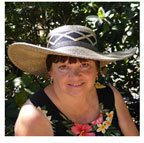Cynthia A. Stiles (USA)

Name: Cynthia A. Stiles
Age: 54
Position: Assistant State Soil Scientist, Hawaii and East Pacific Islands Area
Address: Ewa Beach, HI
E-mail:
1. When did you decide to study soil science?
I was raised on a university research farm, my father was an agricultural engineer who worked hard to preserve soil and water resources, and I always knew I wanted to be in a Natural Resources career. I began my studies in Soil Science in earnest when I began working for an environmental testing company, after I had finished a degree in Agronomy. I pursued my MS in soils and PhD in Geology, although my dissertation project was focused on soils.
2. Who has been your most influential teacher?
There are so many to choose from, it is hard to decide! I have learned from the best, through my career. Aside from my father, who was a priceless life-lesson instructor, I must say that my most influential mentor has been Dr. Chien-Lu Ping. Dr. Ping has instilled a deep love of the pure science and fostered curiosity and exploration everywhere we have gone. He continues to work with me, to develop my skills and to encourage my evolution as a soil scientist.
3. What do you find most exciting about soil science?
It’s hard to decide if the people I work with or the places I get to visit in the field are more exciting. I love being able to visit almost any place on the continents of the planet and explore the soils beneath my feet. I also deeply enjoy sharing knowledge and questions with people where I visit, to see their interest bloom and the understanding expand as we discuss the soils where we are, to hear their stories and expand my own understanding of the soil resource.
4. How would you stimulate teenagers and young graduates to study soil science?
Getting students interested in soils is critical – and there is no better way to do it than to get into the field and show them what soils look like. It’s great to dig pits in urban settings, to show the layers of fill and development, then take the students out to a productive field to show the contrast, then on to a wetland to show the different colors. Talking about soils in the classroom is just not enough – students need to see and feel the soil to get a better grasp of concepts.
5. How do you see the future of soil science?
We are in a world that is less and less in touch with nature, but putting greater pressure on our natural resources. We know much about the fundamentals of soil, now we should use that knowledge to recommend judicious use of soil and water resources, taking our wisdom of the land and sharing it with as many people as we can. We are evolving from a science tied closely with agriculture to a more universal platform and we should work diligently to represent the legacy of our science on this expanding stage.




